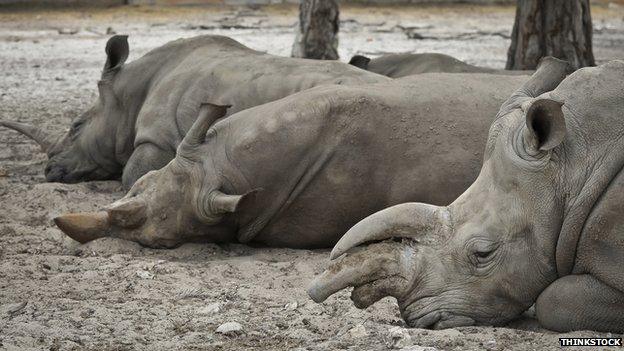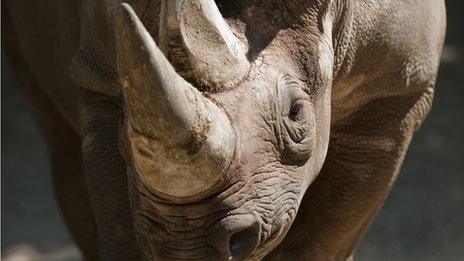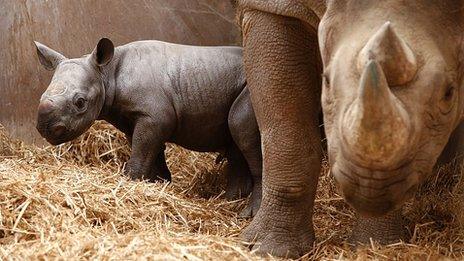Could sound design help captive rhino breeding?
- Published

Captive breeding is crucial because of the threat to wild rhinos posed by poachers
Researchers in Texas are investigating whether the hum and rumble of urban life is one of the factors that hinders the captive breeding of rhinoceroses.
Other research has considered the influence of diet and physical surroundings, but scientists speaking at a conference said they believed the animals' soundscape might be crucial.
Rhinos have extremely good ears, picking up "infrasound" far deeper than the range of human hearing.
Three species are listed as endangered.
"We can go into some zoos and think, this is delightfully quiet - but it might be that some animals don't think it's quiet at all, because urban areas have a lot of chronic infrasound," said lead researcher Suzi Wiseman.
Ms Wiseman, who has just completed a doctorate in environmental geography at Texas State University, presented her preliminary results at a meeting, external of the Acoustical Society of America in Indianapolis.
'Healthy soundscape'
Rhinos, she explained, can hear down to a frequency of four hertz, whereas even a human baby, with entirely undamaged ears, can normally only pick up sounds as low as 20 hertz. Giraffes and elephants can also hear in this infrasound range.
The other end of rhino hearing might also be quite acute, because people have witnessed the animals making high-pitched whistling and giggling noises when adults and youngsters play.
"The soundscape is something that zoos need to consider and it's something that can be improved," Ms Wiseman told the BBC.
She said that although zoos and other institutions had made a lot of effort to make their animals as comfortable as possible, "nobody's really looked at the noise factor".
Scientists at Chester Zoo say they have increased the reproductive success of their critically endangered black rhinos by analysing the animals' dung.
She wants to work with zookeepers to help them provide the best environment possible, for rhinos in particular.
To begin with, Ms Wiseman and her colleagues started by making many, careful recordings with detectors placed around the rhinoceros enclosure at Fossil Rim Wildlife Center in Texas.
Fossil Rim has an "amazing record" of breeding endangered species, Ms Wiseman said, so those recordings are an example of a "healthy soundscape".
She is in the process of analysing that data and building up a larger set of results from other environments.
"I'm trying to get as much information as possible about the entire soundscape, at a variety of different facilities, so we can accurately compare one against the other," Ms Wiseman said.
Then her team would be able to offer advice about measures like sound protection, traffic restrictions, or better locations within a particular zoo, for particular species.
Earlier research has shown that female giant pandas, another famously endangered species that has difficulty breeding in captivity, are especially sensitive to noise when they are pregnant.
Follow Jonathan on Twitter, external

Rhinos have a very wide hearing range and the urban soundscape is very different from the wild
- Published17 January 2014

- Published9 April 2013

- Published14 March 2013
